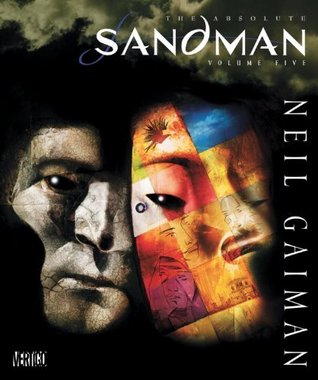The Absolute Sandman, volume 5, 519 pages, both by Neil Gaiman, art by various artists
 After reading all of the initial run of The Sandman, I figured I should finally get around to reading the two Death miniseries, collected in premium format in one of DC Comics' Absolute editions. And then, when borrowing Absolute Death from my brother, I remembered that they put out a fifth Absolute volume for Sandman, which collected all of the Sandman stories that Gaiman wrote after completing the series.
After reading all of the initial run of The Sandman, I figured I should finally get around to reading the two Death miniseries, collected in premium format in one of DC Comics' Absolute editions. And then, when borrowing Absolute Death from my brother, I remembered that they put out a fifth Absolute volume for Sandman, which collected all of the Sandman stories that Gaiman wrote after completing the series.So, as a reminder, Death and her younger brother Dream are two of the Endless, those personifications of traits found in any and all universes. In the Death collection, we get the two issues of Sandman where she features prominently ("The Sound of Her Wings" and "Façade"), as well as a few shorter stories, including "Death Talks About Life," a short comic about practicing safe sex that was released during the height of the AIDS epidemic, and "Death and Venice" that was originally printed in the Endless Nights collection of stories. But the focal point of this collection are the two miniseries, which really work to flesh out Death as a character. In "Death: the High Cost of Living," suicidal sixteen year old Sexton Furnival meets Death, but in human form as a girl named Didi. You see, Death has to take mortal form for one day each century so that she can be reminded of what life is like and what death does to that. This requirement is explained a little further in "A Winter's Tale," also in this Absolute collection, where we learn that Death wasn't always the perky, wise girl that we know today. In "Death: The Time of Your Life," we reencounter Hazel and Foxglove, last seen in A Game of You. Hazel has had her baby, a boy named Alvie, and Foxglove has become an incredibly popular musician. Other than the glimpse we see of the Sunless Lands, which is Death's domain, this story is more about the effects of celebrity than it is about Death, but it's still pretty good.
 In Absolute Sandman, vol. 5, we get the Sandman stories that Gaiman wrote after the series was over. Bookended by both versions of "The Dream Hunters," this collection includes the Endless Nights stories, as well as the collaboration between Gaiman and Matt Wagner, "Sandman Midnight Theatre," where the Golden Age Sandman, Wesley Dodds, meets the modern Sandman, Dream. I've read the P. Craig Russell adaptation of "The Dream Hunters" before, so I enjoyed the chance to read the original prose version with Yoshitaka Amano's art. But my favorite part of this collection is the Endless Nights stories. Each of the Endless get their own story, and the results are great, especially Dream's story. In this story, we meet a younger Endless as they appear at a meeting of stars and other mythical beings. We learn why Dream and Desire are at odds with each other, meet Delight before she became Delirium, and even manage to add a little more lore to the mainstream DC characters. Despair's "Fifteen Portraits of Despair" is also fantastic, if only for its absolutely creepy format.
In Absolute Sandman, vol. 5, we get the Sandman stories that Gaiman wrote after the series was over. Bookended by both versions of "The Dream Hunters," this collection includes the Endless Nights stories, as well as the collaboration between Gaiman and Matt Wagner, "Sandman Midnight Theatre," where the Golden Age Sandman, Wesley Dodds, meets the modern Sandman, Dream. I've read the P. Craig Russell adaptation of "The Dream Hunters" before, so I enjoyed the chance to read the original prose version with Yoshitaka Amano's art. But my favorite part of this collection is the Endless Nights stories. Each of the Endless get their own story, and the results are great, especially Dream's story. In this story, we meet a younger Endless as they appear at a meeting of stars and other mythical beings. We learn why Dream and Desire are at odds with each other, meet Delight before she became Delirium, and even manage to add a little more lore to the mainstream DC characters. Despair's "Fifteen Portraits of Despair" is also fantastic, if only for its absolutely creepy format.So now I can say I've read pretty much everything Sandman. I don't know if I would say that these two collections are absolutely necessary for your understanding of the world Gaiman has built, but, like any good comic, they only enhance and enrich your knowledge of that world. If you're a completist like me, then you'll definitely want to read these.
No comments:
Post a Comment